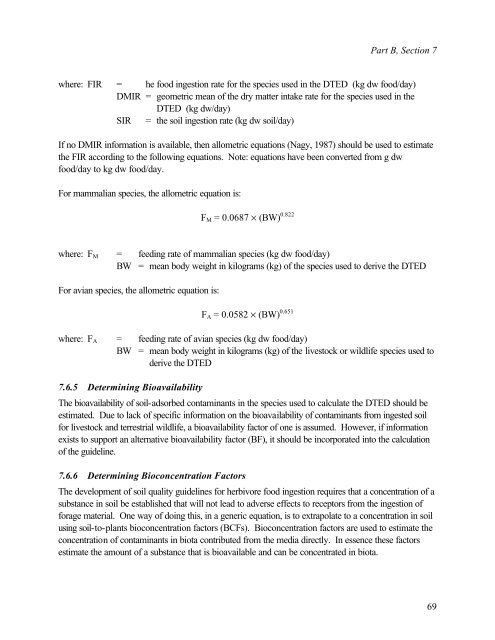Protocol for the Derivation of Environmental and Human ... - CCME
Protocol for the Derivation of Environmental and Human ... - CCME
Protocol for the Derivation of Environmental and Human ... - CCME
Create successful ePaper yourself
Turn your PDF publications into a flip-book with our unique Google optimized e-Paper software.
Part B, Section 7<br />
where: FIR = he food ingestion rate <strong>for</strong> <strong>the</strong> species used in <strong>the</strong> DTED (kg dw food/day)<br />
DMIR = geometric mean <strong>of</strong> <strong>the</strong> dry matter intake rate <strong>for</strong> <strong>the</strong> species used in <strong>the</strong><br />
DTED (kg dw/day)<br />
SIR = <strong>the</strong> soil ingestion rate (kg dw soil/day)<br />
If no DMIR in<strong>for</strong>mation is available, <strong>the</strong>n allometric equations (Nagy, 1987) should be used to estimate<br />
<strong>the</strong> FIR according to <strong>the</strong> following equations. Note: equations have been converted from g dw<br />
food/day to kg dw food/day.<br />
For mammalian species, <strong>the</strong> allometric equation is:<br />
F M = 0.0687 × (BW) 0.822<br />
where: F M = feeding rate <strong>of</strong> mammalian species (kg dw food/day)<br />
BW = mean body weight in kilograms (kg) <strong>of</strong> <strong>the</strong> species used to derive <strong>the</strong> DTED<br />
For avian species, <strong>the</strong> allometric equation is:<br />
F A = 0.0582 × (BW) 0.651<br />
where: F A = feeding rate <strong>of</strong> avian species (kg dw food/day)<br />
BW = mean body weight in kilograms (kg) <strong>of</strong> <strong>the</strong> livestock or wildlife species used to<br />
derive <strong>the</strong> DTED<br />
7.6.5 Determining Bioavailability<br />
The bioavailability <strong>of</strong> soil-adsorbed contaminants in <strong>the</strong> species used to calculate <strong>the</strong> DTED should be<br />
estimated. Due to lack <strong>of</strong> specific in<strong>for</strong>mation on <strong>the</strong> bioavailability <strong>of</strong> contaminants from ingested soil<br />
<strong>for</strong> livestock <strong>and</strong> terrestrial wildlife, a bioavailability factor <strong>of</strong> one is assumed. However, if in<strong>for</strong>mation<br />
exists to support an alternative bioavailability factor (BF), it should be incorporated into <strong>the</strong> calculation<br />
<strong>of</strong> <strong>the</strong> guideline.<br />
7.6.6 Determining Bioconcentration Factors<br />
The development <strong>of</strong> soil quality guidelines <strong>for</strong> herbivore food ingestion requires that a concentration <strong>of</strong> a<br />
substance in soil be established that will not lead to adverse effects to receptors from <strong>the</strong> ingestion <strong>of</strong><br />
<strong>for</strong>age material. One way <strong>of</strong> doing this, in a generic equation, is to extrapolate to a concentration in soil<br />
using soil-to-plants bioconcentration factors (BCFs). Bioconcentration factors are used to estimate <strong>the</strong><br />
concentration <strong>of</strong> contaminants in biota contributed from <strong>the</strong> media directly. In essence <strong>the</strong>se factors<br />
estimate <strong>the</strong> amount <strong>of</strong> a substance that is bioavailable <strong>and</strong> can be concentrated in biota.<br />
69
















